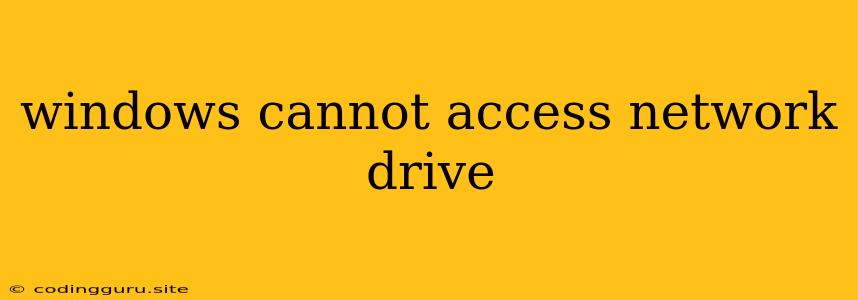Windows Cannot Access Network Drive: Troubleshooting and Solutions
Many users encounter the frustrating error message "Windows cannot access the network drive" when attempting to connect to a shared folder on a network. This error can stem from various causes, making troubleshooting a bit challenging. But don't worry, this guide will walk you through the most common reasons behind this issue and provide clear steps to help you regain access to your network drive.
Common Causes of "Windows Cannot Access Network Drive" Error
- Incorrect Credentials: The most frequent reason is simply using the wrong username or password when trying to access the network drive. Double-check your credentials and ensure you're using the correct information.
- Network Connectivity Issues: If your computer cannot connect to the network properly, accessing network drives becomes impossible. Verify your network connection by checking your internet connection or the network cable.
- Shared Folder Permissions: Sometimes, you might lack the necessary permissions to access a shared folder. Check if the folder is properly shared and you have the required privileges.
- Network Drive Mapping Issues: Incorrectly mapped network drives can lead to this error. Ensure that the drive is correctly mapped to the correct network location.
- Firewall or Antivirus Interference: Your firewall or antivirus software may block access to the network drive, particularly if it's using an unfamiliar network protocol or connection.
- Drive Letter Conflict: If the drive letter assigned to the network drive is already in use by another drive on your computer, you might encounter this error.
How to Fix the "Windows Cannot Access Network Drive" Error
Here's a step-by-step guide to resolving the "Windows cannot access network drive" error:
- Verify Your Credentials:
- Start by double-checking your username and password.
- If you're using a different account, ensure you're logging in with the correct one.
- Example: If you're connecting to a drive shared on your home network, you might need to use your local user account name and password.
- Check Network Connectivity:
- Test your internet connection: Open your browser and navigate to a website. If you can access the internet, your connection is likely working.
- Verify network cable connection: If you're using a wired connection, make sure the cable is firmly connected to both your computer and the router.
- Restart your router: This can sometimes resolve temporary network connection issues.
- Check Shared Folder Permissions:
- Right-click on the network drive: Select "Properties".
- Go to the "Sharing" tab: Verify that the folder is shared.
- Click "Permissions": Ensure you have the necessary access rights to the folder.
- Verify and Remap the Network Drive:
- Open File Explorer: Navigate to "This PC".
- Click "Map Network Drive": Input the correct network path for the shared folder.
- Enter your credentials: Use the correct username and password.
- Check the "Reconnect at logon" box: This ensures the drive is automatically connected when you log in.
- Temporarily Disable Firewall and Antivirus:
- Temporarily disable your firewall: This can help identify if it's causing the issue. However, only disable it for testing purposes and re-enable it afterward.
- Disable your antivirus temporarily: This can also potentially resolve the issue. But, again, only disable it temporarily for testing and re-enable it as soon as possible.
- Check for Drive Letter Conflicts:
- Open Disk Management: Right-click on the "This PC" icon and select "Manage".
- Go to "Disk Management": Check if the drive letter assigned to the network drive is already used by another drive.
- Change the drive letter: If there's a conflict, you can assign a different drive letter to the network drive.
- Restart Windows:
- Sometimes, a simple restart can resolve temporary system errors that may be preventing access to the network drive.
- Check for Windows Updates:
- Outdated drivers or operating system versions can cause network-related problems. Ensure your Windows system is up to date with the latest updates.
- Check for Network Adapter Driver Issues:
- Outdated or faulty network adapter drivers can affect network connectivity. Update your network adapter drivers to the latest version.
- Run Network Troubleshooter:
- Go to "Settings" > "Update & Security" > "Troubleshoot":
- Select "Network Adapter" and run the troubleshooter: It will automatically diagnose and attempt to resolve any network issues.
Conclusion
The "Windows cannot access network drive" error can be frustrating, but by following these troubleshooting steps, you should be able to regain access to your shared network folder. Remember to verify your credentials, check network connectivity, and ensure appropriate permissions are set. If none of these solutions work, consider contacting your network administrator or seeking help from Microsoft Support.
